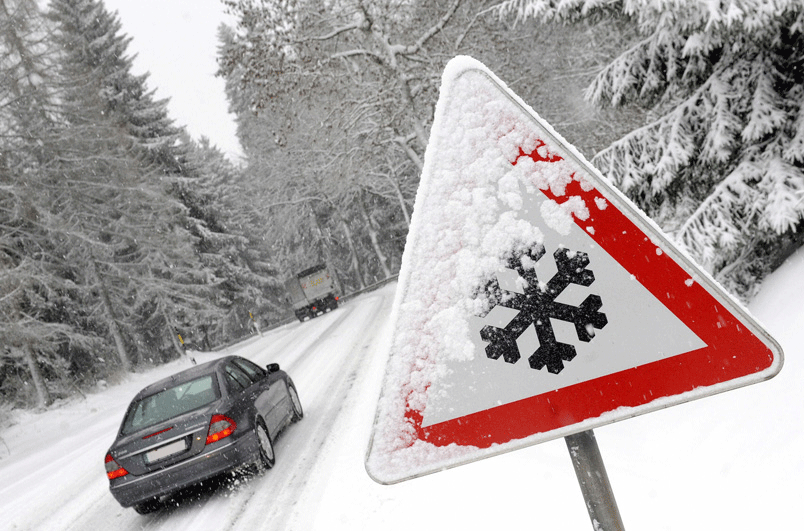How to survive winter driving: it can be treacherous and stressful. Snow, ice, freezing rain and sub-zero temperatures all combine to make driving in the winter dangerous and, potentially, life threatening. Most people dislike driving in winter conditions no matter what type of vehicle they own. The good news is that there are several steps people can take to protect themselves when behind the wheel in winter, and lessen the chances of having an accident or getting stuck in frigid conditions. Here are 12 survival tips for driving during the winter months.
12. Check Weather and Road Conditions Frequently
Weather can change quickly and a storm can develop, seemingly, out of nowhere. For these reasons, it is important that people check on the weather and road conditions in their area on a regular basis. Also, be sure to plan the route you’ll take to a particular destination ahead of time and know if there are any road closures due to accidents or winter road maintenance before you head out. Many municipalities have apps that show the location of snow plows in a particular city or town. This information too can be helpful as snow plows working in a certain area can cause traffic delays. The bottom line is that you can never have too much information when it comes to winter road conditions.
11. GPS Is Your Friend
The U.S. military uses Global Positioning Systems (GPS) to help them navigate in blinding sand storms when visibility in the desert is near zero. This same concept should be applied to driving during a snow storm when the visibility is extremely poor. The devices can tell you when to take an off ramp on a highway even if you can’t see the off ramp yourself. It can also direct you on alternate routes to your destination should you miss a turn due to heavy snowfall that makes it difficult to see. In essence, GPS gives drivers an extra set of eyes when they need it most—during heavy snow or blizzard conditions. A GPS can also help pinpoint your location should you become stranded.
10. Keep a Survival Kit in Your Vehicle
A winter survival kit in the trunk of your vehicle can help in the event that you become stranded or stuck on the side of the road for an extended period of time. The kit can include items such as a blanket, an extra set of mitts or gloves, booster/jumper cables, a small shovel, windshield wiper fluid, a first aid kit, a flashlight, snow brush, a safety vest, bottled water and food items that won’t go bad such as granola bars or energy bars. Pack this kit, place it in the trunk and forget about it unless you become stranded and need it. This type of survival kit can go a long way to helping people who become stuck in a blizzard or other winter hazards while they wait for help to arrive. After all, there is no guarantee that the battery in a car will continue operating and that the engine will stay running to keep heat inside of the vehicle.
9. Travel With a Charged Cell Phone and Keep Emergency Numbers Within Reach
Another element of survival would be to always travel in winter with a fully charged cell phone and keep emergency phone numbers either in the cell phone itself or on a piece of paper in the glove compartment of the car. These emergency numbers could include the number of state police, highway patrol, your vehicle insurer, friends and family, and so forth. The most important thing to do when stranded or in trouble is to call for help. And there would be nothing worse than to reach for your cell phone in an emergency only to find that the battery is dead. So be sure to keep the phone charged at all times.
8. Clear Snow and Ice From Your Car
This might seem pretty obvious to most people, but you would be amazed at how many people set out with their car covered in snow and ice. And it is not just important to scrape snow and ice off the vehicle’s windows. Motorists should also clear snow and ice from the car’s side mirrors, headlights and roof. This will not only ensure that you can see properly, but also that other drivers can see your vehicle on the road. Equally important is for people to wait for the mirrors in their car to properly defrost. Many people jump in their vehicle in the morning and take off with the windows so foggy they can’t see out of them for 10 minutes or longer. This is extremely dangerous. Car windows should always be thoroughly defrosted before driving anywhere.
7. Keep Away From Snow Plows
Snow plows can be unpredictable and dangerous. Additionally, snow plow drivers do not have the best visibility and may not see you behind them. Also, snow plows kick up a lot of snow and could make it seriously hard for you to see anything when driving behind one. If you do find yourself stuck behind a snow plow, be sure to maintain a safe distance. Move around or away from a snow plow at the first opportunity, and, if necessary, flash your high beams at the snow plow operator to let him or her know that you are behind them. Always drive defensively when behind a snow plow. And note that snow plows can turn suddenly and unexpectedly, so stay back and stay safe.
6. Allow Extra Time to Get Where You Are Going
People are more rushed and hurried today than ever before. But if there is ever a good time to slow down and give yourself extra time, it is during the winter. Always drive based on the winter road conditions and give yourself extra time to get where you’re going. This will not only make life less stressful, but it will help to ensure that you do not drive too fast and risk an accident on icy roads or in snowy conditions. Slowing down and driving at a more moderate and manageable speed is important and sound advice. Rushing and driving too fast is the surest way for people to get into an accident when navigating a vehicle in winter conditions.
5. Dress in Layers and Wear Comfortable Clothes
It’s never a good idea to wear clothes that are too bulky or heavy when driving in the winter. This is because big, bulky and heavy clothing can restrict a driver’s movements and make it difficult to check blind spots or work the controls in a car. Best to dress in layers and strip out of heavy coats and sweaters while inside a vehicle. Let the car’s heater keep you warm while you drive to your destination. On long trips, be sure to wear comfortable clothes that will keep you loose and relaxed while making your way through snow, sleet and icy conditions. All this said, ensure that you do have appropriate winter wear in the car should you get stranded and need to exit the car in sub-zero temperatures.
4. Keep the Gas Tank Full
Running out of gas is a pain in the butt under the best of conditions. During the winter, it can cause a life or death situation. So always keep the gas tank in the car full. A full tank of gas also helps to reduce moisture in the vehicle’s fuel system and adds extra weight that can help slow down a car, truck, SUV or minivan. Any way you look at it, driving with a full tank of gas is a good idea at any time of year—but it is especially prudent during the winter months when freezing temperatures mean that nobody wants to get stuck on the side of a road or highway. Highway patrol departments say that running out of gas is one of the biggest problems they encounter during the winter each year. So do yourself a favor and avoid it.
3. Never Use Cruise Control on Slippery Roads
Some drivers are addicted to their cruise control and use it whenever the opportunity presents itself. But this is a “no-no” in winter and on slippery streets and highways. It is way too easy for motorists to lose control of their vehicle in bad weather when using cruise control. Always maintain complete control over the car you’re driving and the speed you’re traveling at during the winter. Of course if road conditions are particularly hazardous, such as during an ice storm or raging blizzard, it would be best to stay home and not drive at all. But certainly never use cruise control in winter driving conditions. It is a recipe for disaster and could be life-threatening.
2. Learn How to Use Your Car’s Anti-Lock Braking System (ABS)
Many vehicles today come with features that could be extremely helpful in winter driving conditions such as front wheel drive, four wheel drive and an anti-lock braking system (ABS). Unfortunately, most folks don’t take the time they need to figure out how to use these options properly and effectively in bad driving conditions. This is a shame as anti-lock brakes can be very beneficial when driving on snow and ice. Taking time to use these items when needed can be a big help. It will also make you feel good about having paid for these features in the first place. So go dig out that owner’s manual and take a few minutes to learn how to use the four wheel drive and ABS on your car or truck.
1. Drive on Winter Tires
Is it too obvious to say that people who live in northern U.S. or in Canada should drive on winter tires? We think not. Because many people are still holding out and refusing to buy winter tires. For this reason, some jurisdictions, such as the Canadian province of Quebec, have made it the law for all motorists to use winter tires. Studies have shown that winter tires are effective and save lives. They dramatically improve grip and braking ability compared to regular tires or even all-season tires. And the price to buy the tires and have them installed is dropping all the time, making them increasingly cost effective. One set of winter tires should easily last five years or longer. Just don’t drive on winter tires in the summer months or risk wearing the treads out quickly. A great and practical investment no matter how a person looks at it, winter tires are the number one thing people should use when driving during the harsh winter months.
So there you have it, and when roads are optional, give Lite Trax a call for your snow traveling needs!

